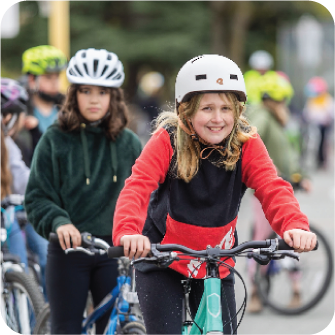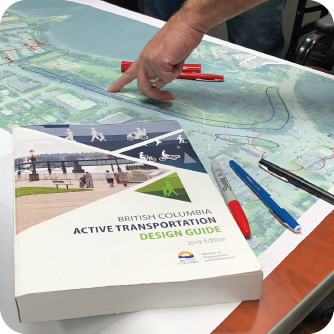Active transportation education and encouragement

The B.C. government funds and supports programs and events that build and improve active transportation infrastructure and encourage people to choose active transportation to get around.
On this page:
- Active transportation for schools
- Active transportation for everyday travel
- Active transportation for local governments
- Active transportation resources
Spreading the word about active transportation helps more British Columbians discover this healthy and efficient travel option.
Active transportation programs and events:
- Inform people of all ages and abilities how to get started with active transportation
- Increase adults’ and children’s confidence
- Improve safety for all road users
- Encourage everyone to choose active transportation for more trips
Learn more about active transportation funding and pilot projects that support active transportation.
Active transportation for schools

Starting active transportation early can create lifelong habits. The B.C. government supports programs that help children and youth cycle, walk, and roll to and from school safely.
Active transportation for students supports kid's physical and mental health while improving air quality and congestion around schools.
EveryoneRides
Grade 4 & 5
The B.C. government has invested over $2.5 million in the Everyone Rides Grade 4 & 5 program since 2020. The program is reaching 65% of eligible schools and 75% of eligible students across the province. That’s over 15,000 students over the 2024-2025 school year.
The EveryoneRides program gets children in grades 4 and 5 bike education in their own schools. Kids start inside with a safety class and then hop on their bikes to build their skills outdoors.
EveryoneRides program is in communities across the province. Sessions are delivered by HUB Cycling and other local partners. The online component of EveryoneRides, Learn2Ride Online, is available for free, self-guided learning.
Interested in getting the Everyone Rides Grade 4-5 program at your school? Contact EveryoneRides@bikehub.ca to find out what funding and resources are available in your community.
Walking and Biking School Bus
When kids walk, bike or roll to school, they improve their physical and mental health. Supervised walks and organized rides for elementary age children help them start their day with fresh air and exercise. Not only that, fewer vehicles on the road reduces carbon emissions and increases neighbourhood road safety. Over the 2023/2024 school year the Walking School Bus travelled 14,400 kilometres, preventing 3 tons of carbon emissions.
The Walking School Bus program is currently at schools in 15 communities. The Biking School Bus is at schools in 10 communities. In total, 600 students are expected to participate over the course of the program.
School Streets
The BC School Streets Initiative provides children with safer environments that encourage physical activity by creating car-free spaces on streets in front of schools at the start and/or end of the school day. School streets initiatives have been shown to reduce driving to school by 21% and lower air pollution by 23%.
The BC School Streets Initiative will include interventions that range from a one-week pop-up event to a month-long pilot. Ten communities across the province will receive support through provincial funding and build on federal funding supporting the program in three locations.
Active transportation for everyday travel

Removing barriers to active transportation and encouraging uptake of cycling and other modes of personal mobility leads to healthier, happier, more connected communities.
Walking, cycling, or rolling is an affordable, healthy, convenient, and environmentally friendly option for everyday travel and short local trips.
Cycling education
Funding from the B.C. government supports the delivery of cycling courses, including e-bike specific education. In-person courses are available in selected communities.
For low-barrier online cycling education try Streetwise Cycling Online.
GoByBike
The B.C. government is proud to have supported and participated in bike to work and school events for over a decade.
Bike to work and school events, like GoByBike, motivate people to try commuting by bicycle. Supportive teams and fun prizes attract more new riders every year. In 2024, over 62,000 participants rode 2.7 million kilometres, avoiding nearly 580,000 kilograms of carbon emissions.
GoByBike for schools has resources for how to start a school team.
Watch the video to learn more about the GoByBike program and the benefits of biking to work or school.
Project 529
In 2024, the B.C. government provided funding to expand use of the Project 529 bike registration service province-wide. Thanks to this funding, 55 law enforcement agencies, 7 post-secondary institutions, and 31 community organizations are currently partnered with Project 529.
Project 529 allows people to register details of their bikes in a database that can be accessed by police and used to report a stolen bike. When stolen bikes are recovered, the police can connect the bike with the owner, improving the chances of a successful return. Project 529 has been shown to reduce bike theft by approximately 40% on average in participating communities.
Register your bike online or use the 529 Garage app on your mobile device to receive notifications.
Bike Valet Grant
Bike valets are services where bike riders are able to check and leave their bike with an attendant at a supervised area. These services prevent bike theft and encourage cycling to places like farmers markets, festivals and central business districts.
Starting in 2024, the B.C. government has provided funding to the BC Cycling Coalition for a grant program to support the creation and expansion of bike valets across the province.
Data from the first year of the grant program shows that 35% of trips to bike valets would have otherwise been made by motor vehicle. With over 26,000 visits to grantee valets, this suggests that grant funding created hundreds of additional trips while shifting over 8,000 people out of cars.
Tourism and recreational cycling
Check out BC Parks for information on cycling activities, destinations, and regulations in parks across B.C.
Super, Natural BC has mountain biking, road biking, and bicycle touring routes.
Active transportation for local governments

Planners, engineers, local governments and advocacy groups can access design best practices that promote safe and accessible active transportation travel, support community environmental goals and decrease traffic congestion.
Grants for local government provide cost-sharing opportunities for network planning grants and infrastructure grants.
B.C. Active Transportation Infrastructure Grants Program
The B.C. Active Transportation Infrastructure Grants Program offers two grant options for municipalities, regional districts, Islands Trust, and Indigenous Economic Development corporation where the Nation is the shareholder. The application intake is usually in September. Indigenous applicants or partnership applicants may apply at any time in the year through the rolling intake. Since 2020, nearly $100 million has been awarded in grants to 327 projects.
Sign up to be notified of updates to the Active Transportation Grants Program.
Active transportation infrastructure design
Follow these recommended policies, specifications, standards and guidelines when developing active transportation infrastructure in B.C.
The Active Transportation Design Guide and supplementary island platform bus stops adjacent to cycling infrastructure reflects evolving engineering best practices. Local and regional government staff, representatives of other government agencies, Indigenous communities, advocacy groups, professional associations, and academics can provide feedback to ActiveTransportation@gov.bc.ca to help improve guide contents.
The B.C. Supplement to TAC (2019) provides road design guidelines for the B.C. highway system.
Active transportation resources
Rules and resources
New releases
Contact information
Contact us if you have questions about active transportation education and encouragement.
